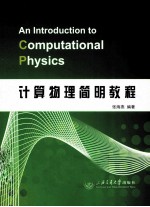

计算物理简明教程=AN INTRODUCTION TO COMPUTATIONAL PHYSICSPDF电子书下载
- 电子书积分:11 积分如何计算积分?
- 作 者:张海燕编著
- 出 版 社:上海交通大学出版社
- 出版年份:2010
- ISBN:9787313066688
- 页数:259 页
1 Approximations,Errors and the Taylor Series 1
1.1 Approximations and Errors 2
1.1.1 Approximations 2
1.1.2 Round-off Errors 4
1.1.3 Principles to Hold During the Numerical Calculations 5
1.2 Truncation Errors and the Taylor Series 7
1.2.1 Truncation Errors 7
1.2.2 The Taylor Series 8
1.2.3 Some Techniques in Numerical Computation 11
1.3 Control of Total Numerical Error 12
1.3.1 Truncation Error 12
1.3.2 Total Numerical Error 13
1.3.3 Control of Numerical Errors 14
1.4 Problems for Chapter 1 15
1.5 Computer Work for Chapter 1 16
2 Interpolation and Finite Differences 18
2.1 Finite Difference 20
2.2 Newton Interpolation 21
2.2.1 Basis Functions 22
2.2.2 Newton Interpolation 23
2.2.3 Newton’s Divided-difference Interpolating Polynomial 25
2.2.4 Errors of Newton Interpolation 28
2.3 Interpolation Formulae 30
2.3.1 NGF Interpolation 30
2.3.2 NGB Interpolation 31
2.3.3 ST Interpolation 31
2.4 Difference Quotients 32
2.4.1 DNGF Formulae 33
2.4.2 DNGB Formulae 34
2.4.3 DST Formulae 35
2.5 Problems for Chapter 2 38
2.6 Computer Work for Chapter 2 39
3 Numerical Integration 41
3.1 Numerical Integration Methods 41
3.2 Newton-Cotes Quadrature Rules 43
3.2.1 The Trapezoid Rule 44
3.2.2 Simpson’s Rule 45
3.2.3 Error Estimation 47
3.3 Composite and Adaptive Quadrature 50
3.3.1 Composite Quadrature Rules 50
3.3.2 Automatic and Adaptive Quadrature 55
3.4 Numerical Integration of Multi-dimensional Integrals 58
3.5 Problems for Chapter 3 61
3.6 Computer Work for Chapter 3 62
4 Matrix Algebra 63
4.1 Types of Matrices 64
4.2 Gauss Elimination and Back Substitution 66
4.2.1 The Elimination of Unknowns 66
4.2.2 The Algorithm of Gauss Elimination and Back Substitution 67
4.2.3 Techniques for Improving Solutions 72
4.3 LU Decomposition and Matrix Inversion 74
4.3.1 Overview of LU Decomposition 74
4.3.2 LU Decomposition Algorithm 76
4.3.3 Procedure from Gauss Elimination 79
4.3.4 The Matrix Inverse and Error Analysis 83
4.4 Tridiagonal Matrices and Recursion Method 85
4.4.1 Tri-diagonal Systems 86
4.4.2 Recursion Method 89
4.5 Iterative Methods 92
4.6 Jacobi Method 95
4.6.1 The Algorithm 95
4.6.2 The Convergency 96
4.7 Gauss-Seidel Method(GS) 97
4.7.1 The Algorithm 97
4.7.2 The Convergency 99
4.8 Successive Over-Relaxation Method(SOR) 99
4.9 Conjugate Gradient Method(CG) 102
4.9.1 The Gradient 104
4.9.2 Steepest Descent Method 107
4.9.3 CG Method 109
4.10 Problems for Chapter 4 115
4.11 Computer Work for Chapter 4 116
5 Ordinary Differential Equations 118
5.1 Types of Differential Equations 119
5.2 Euler Method 122
5.2.1 Error Analysis 124
5.2.2 Stability 126
5.2.3 Application to Vector Equations 130
5.3 The Leapfrog Methods 131
5.3.1 Stability Analysis 132
5.3.2 Generalization to Multi-step Scheme 133
5.4 Implicit Methods 135
5.4.1 The Most Fundamental Scheme 135
5.4.2 Implicit Scheme of Second Order——Improved Euler Method 138
5.5 The Runge-Kutta Method 140
5.5.1 The Basic Idea of Runge-Kutta Method 140
5.5.2 Stability Analysis 143
5.5.3 Adaptive RK Method 146
5.6 Predictor-Corrector(PC)Method 149
5.7 Boundary Value Problems and Initial Value Problems of Second Order 156
5.7.1 Shooting Method 158
5.7.2 Numerov’s Method 164
5.8 Problems for Chapter 5 166
5.9 Computer Work for Chapter 5 167
6 Partial Differential Equations 168
6.1 Types of Equations 168
6.2 Elliptic Equations 170
6.2.1 Two or More Dimensions 172
6.2.2 ADI(alternating direction implicit)Method 177
6.3 Hyperbolic Equations 181
6.3.1 The FTCS Scheme 184
6.3.2 The Lax Scheme 186
6.3.3 Leapfrog Scheme 189
6.4 Parabolic Equations 191
6.4.1 A Simple Method——FTCS Scheme 192
6.4.2 Implicit Scheme of First Order 195
6.4.3 Crank-Nicholson(CN)Scheme 197
6.5 Five-point Stencil for 2D Poisson Equation in Electromagnetic Field 200
6.6 Problems for Chapter 6 206
6.7 Computer Work for Chapter 6 207
7 Monte Carlo Methods and Simulation 208
7.1 Probability 210
7.1.1 Chance and Probability 210
7.1.2 A One-dimensional Random Walk 211
7.1.3 Probability Distribution 213
7.1.4 Random Variables 215
7.2 Random Number Generators 217
7.2.1 Linear Gongruential Generators 218
7.2.2 Shift Register Generators 220
7.3 Non-uniform Probability Distribution 222
7.3.1 Inverse Transform Method 222
7.3.2 Generalized Transformation Method——Box-Muller Technique 225
7.4 Monte Carlo Integration 227
7.4.1 Splash Method(Hit or Miss Method) 227
7.4.2 Sample Mean Method 229
7.4.3 Two Theorems in Probability Theory 230
7.4.4 MC Error Analysis 231
7.4.5 Importance Sampling Technique 236
7.5 Stochastic Dynamics 239
7.5.1 Random Sequences 239
7.5.2 Stochastic Dynamics 242
7.6 Monte Carlo Simulation and Ising Model 246
7.6.1 Simulation Methods 246
7.6.2 Random Walk Methods 248
7.6.3 The Ising Model 249
7.6.4 The Metropolis Algorithm 252
7.7 Problems for Chapter 7 256
7.8 Computer Work for Chapter 7 257
Bibliography 259
- 《计算机网络与通信基础》谢雨飞,田启川编著 2019
- 《高级英语阅读与听说教程》刘秀梅编著 2019
- 《大学计算机实验指导及习题解答》曹成志,宋长龙 2019
- 《看图自学吉他弹唱教程》陈飞编著 2019
- 《激光加工实训技能指导理实一体化教程 下》王秀军,徐永红主编;刘波,刘克生副主编 2017
- 《AutoCAD 2019 循序渐进教程》雷焕平,吴昌松,陈兴奎主编 2019
- 《少儿电子琴入门教程 双色图解版》灌木文化 2019
- 《Photoshop CC 2018基础教程》温培利,付华编著 2019
- 《剑桥国际英语写作教程 段落写作》(美)吉尔·辛格尔顿(Jill Shingleton)编著 2019
- 《名医教你练走颈肩腰腿痛》许学猛 2018
- 《市政工程基础》杨岚编著 2009
- 《家畜百宝 猪、牛、羊、鸡的综合利用》山西省商业厅组织技术处编著 1959
- 《《道德经》200句》崇贤书院编著 2018
- 《高级英语阅读与听说教程》刘秀梅编著 2019
- 《计算机网络与通信基础》谢雨飞,田启川编著 2019
- 《看图自学吉他弹唱教程》陈飞编著 2019
- 《法语词汇认知联想记忆法》刘莲编著 2020
- 《培智学校义务教育实验教科书教师教学用书 生活适应 二年级 上》人民教育出版社,课程教材研究所,特殊教育课程教材研究中心编著 2019
- 《国家社科基金项目申报规范 技巧与案例 第3版 2020》文传浩,夏宇编著 2019
- 《流体力学》张扬军,彭杰,诸葛伟林编著 2019
